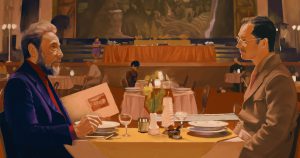
In French critic Ronald Barthes’ essay ‘Leaving the Movie Theatre’, he focused on analyzing the fascination that a movie theatre brings to spectators. Start from a description of how a man leaves the theatre, Ronald Barthes treated the experience in movie theatre as a kind of hypnosis. Features of the ambient affect the watchers and create the ‘cinema situation’. Additionally, Barthes notice the casual relationship between the cinema’s fascination and the features of spectators: The spectators go to the cinema in response to idleness, leisure and free time. The darkness inside the movie hall, along with other elements of the certain environment, is able to manipulate the hypnosis and create the ‘twilight reverie’ experience.
Nowadays, spectators don’t have to bother to pay a long journey for the cinema. Netflix, YouTube and other websites provide millions of audio and video resources, which are all available on your mobile devices. Nevertheless, different from the televisions, laptops and phones in a familiar living environment, cinema’s environment of “Darkness” has a substance of reverie and are able to creates the fascination. Cinema reduces the distractions and create the so-called “darkness” surroundings to makes people focus on the movie played on the screen. This process of “concentrating” happening inside the cinema protect the movie industry and the cinema itself in a way. It is safe to conclude that the cinema hall has become an organic part in spectators’ aesthetic experience.
Apparently, a lot of people are aware of the relationship between movie and cinema (the hall, the screens and the audio system). For instance, The Grand Budapest Hotel (2014), the director Wes Anderson manipulated three different aspect ratios to represent different time periods, namely, 1.37:1 for 1932, 1.85:1 for 1968 and present scale of 2.35:1. Through variant aspect ratios, director Anderson recalled his spectators of film-watching experience in different historical times, even if most of them haven’t really gone through those old days of cinema.
DONG YUCHEN UID: 3035448859
It is fascinating to see how the idea of cinema has changed so rapidly in the recent decade, through physical theaters and filming techniques. A very interesting point about aspect ratios in The Grand Budapest Hotel (2014), but other than reading reviews and comments on the film techniques, it might be even more provocative to argue whether this is successful attempt by the director to convey time to the mass audience. Especially as a student in current generation, like you have said, “have not really gone through those old days of cinema”.